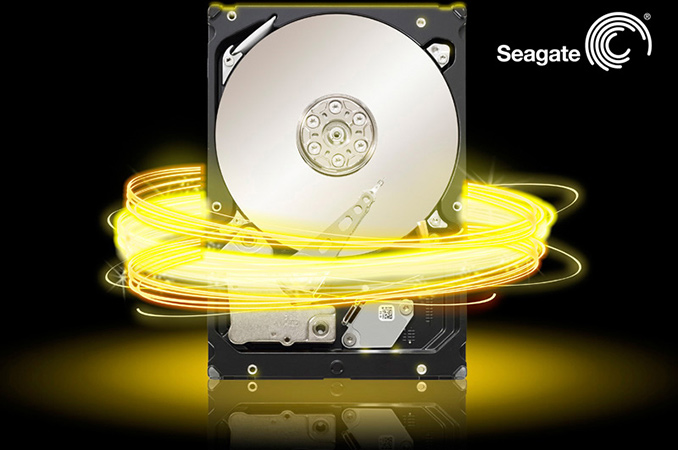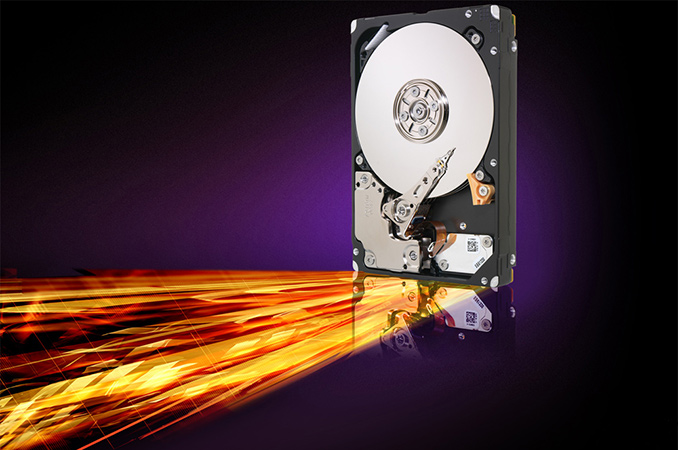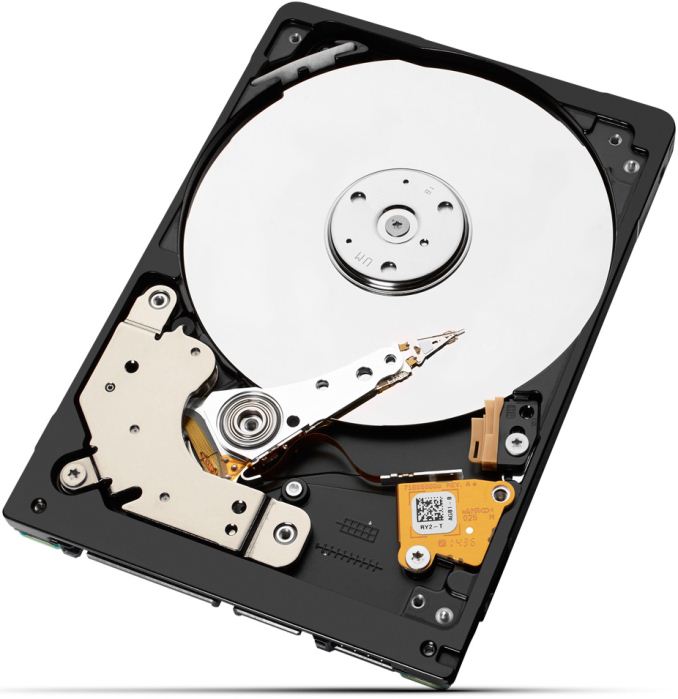Seagate Confirms Plans for 12 TB HDD in Near Future, 16 TB HDD Due in 2018
by Anton Shilov on January 30, 2017 2:00 PM EST
The CEO of Seagate has confirmed plans to release new nearline harddrives with 12 TB capacity in the coming months, and HDDs with 16 TB capacity over the course of the next several quarters. The latter are believed to be based on HAMR technology and the comment by the CEO essentially means that the company is on track with its next generation of heat assisted magnetic recording technology.
12 TB HDDs Incoming
Seagate’s CFO confirmed plans to release nearline HDDs with 12 TB capacity in early November, 2016. Last week Steve Luczo, CEO of Seagate, said that such drives had been evaluated by the company’s customers for about two quarters now and the feedback about the drives had been positive. He did not elaborate on the exact launch timeframe for the product, but given the fact that the drive is nearly ready, it is logical to assume that the 12 TB HDD should be announced formally in the coming weeks or months.
The hard drive maker has not revealed many details about its 12 TB Nearline HDD so far, but previously Seagate disclosed that this drive is filled with helium and is based on PMR technology, whereas last week the company implied that it uses eight platters. Keeping in mind that Showa Denko recently launched 1.5 TB platters for 3.5” drives, it is likely that Seagate uses eight of such platters for its 12 TB HDDs. In fact, Western Digital’s HGST Ultrastar He12 HDD with 12 TB capacity introduced last December comes with eight PMR disks as well.
“As you know, going from 8 to 10 to 12 to 16 [TB], you are going from six to eight disks, at least, on the nearline products,” said Steve Luczo, CEO of Seagate, during a conference call with investors and financial analysts.
16 GB HAMR HDDs in 12 to 18 Months
The 12 GB drive will be Seagate’s top-of-the-range model for enterprise and other demanding applications for quite a while and will become the company’s highest-capacity PMR-based drive. But, for the second time last week, the company mentioned 16 TB HDDs due in the next 12 to 18 months. Moreover, since such drives will be based on HAMR technology (Seagate discussed the feasibility of HAMR-based HDDs at 16 TB last year), they will cause a certain level of disruption on the market.
“During the next 12 to 18 months, we expect the nearline market to be diversified in capacity points for different application workloads, with use cases from 2 to 4 TB products for certain applications up to 16 TB for other use cases,” said Mr. Luczo.
Hard drives featuring heat-assisted magnetic recording technology will cost more to build compared to traditional HDDs because of the increased number of components and use of new materials. As a result, such drives will also be more expensive to actual customers. At present, we do not know specifics, but what Seagate says is that in the future the market of nearline HDDs will get more diverse and its lineup will get wider. In the past, the product stack used to remained similar, and as larger drives were introduced every year, previous-gen products were moved down the stack and low-capacity models discontinued. This may not be the case in the future and customers who need maximum capacity (i.e., who would like to store 3840 TB of data per rack and require 16 TB drives) in 2018 will probably have to pay more than they pay for leading edge HDDs today.
It is noteworthy that Seagate also mentioned 14 TB and 20 TB HDDs in the conference call, but without specifics, it does not sound like a good business to make assumptions about them. So far, the company has not explicitly announced any plans to release SMR-based 14 TB HDDs for specific workloads to compete against Western Digital’s Ultrastar He14.
Higher-Capacity Consumer Drives In Demand
Moving on with the comments made by the head of Seagate, we noticed that Mr. Luczo also mentioned higher-capacity HDDs for consumer applications. In particular, when talking about increasing amount of disks and heads per drive, CEO of Seagate indicated that the numbers are also increasing for consumer HDDs as well.
“We do think there [are] opportunities for more heads and disks on desktop and notebook, as people need higher capacity as well,” said Steve Luczo.
Keeping in mind that Seagate currently offers BarraCuda Pro desktop HDDs with 6 TB, 8 TB and 10 TB drives for consumers, and these drives use enterprise-class platforms (albeit with multiple changes). The remark by the CEO is an indication that the company will keep doing so in the future. Meanwhile it is interesting to note that the head of Seagate also mentioned mobile drives with increased number of platters and heads, hinting on increasing demand for higher-end 2.5” HDDs with more than one platter. At present, Seagate offers 5TB drives in a 2.5-inch form factor, although these come in at 15mm and typically tend not to fit in most mobile environments.
Related Reading:
Source: Seagate
















31 Comments
View All Comments
wumpus - Sunday, February 5, 2017 - link
The Ferrari comparison isn't that far off: at least consumer flash runs 10x more per $/gig than rotational media. I'd understand if tape was eating rotational media from below (can anybody undercut Amazon for backup using tape? Is anybody, it should be possible?), but I'm not seeing it.If anything, I'd assume that such companies would be buying rotational media for backups (except for organizations with hard rules about "hard drives are not backup, use punch cards instead".
It would be extremely odd if Moore's law (for silicon) died almost identically with the inability of magnetic media to continue to scale, but that appears to be happening. It might just be that flash has eaten enough of rotational media's lunch that they can't afford the huge R&D costs to keep going. Remember, while flash isn't eating all of rust's lunch, it certainly is eating the most profitable.
close - Monday, February 13, 2017 - link
Tape is a great technology... until you have to restore a backup and the time you lose restoring from tape costs a lot more than backing up to disk. And then you give backup to disk a chance :).Flash is far from cheap enough to use anywhere else but performance critical applications and caching.
marvdmartian - Thursday, February 2, 2017 - link
Really, though, the only benefit to a hard drive, over an SSD, currently, is $$/GB. When you see 1TB SSD's going on sale for ~$250 (meaning, ~$0.25/GB, before formatting, of course), then realize that even 20 years ago, hard drives had barely (or not quite yet) reached $1/GB, it's nothing more than a matter of time, before larger capacity will be the ONLY benefit of an HDD over an SSD.My first home-built rig, in late 2001, had a WD 80GB "Black" hard drive, that I paid $80 for, on sale. What a steal!!
Laststop311 - Monday, January 30, 2017 - link
I could see eventual need to move from 4TB drives in the NAS with 4k UHD BD images. Currently everything fits in a 6 disk raid 5. But with 4k blu ray disc image double the size and as movies i want increase in number I could see moving to 10-12TB.valinor89 - Monday, January 30, 2017 - link
I just noticed I actually have less data space now than I had 5 years ago since I got 200MB simetric fiber...I still download huge files, but I don't keep them. I know I am not a syvarite 4k BR Movie packrat but I doubt I will need more than a couple TB of storage. Including an SSD for my SO and games in my PC and another 2 for important files offline backup.
Also, if anything HDDs have not gone down in price as a 5 year interval would suggest.
Laststop311 - Tuesday, January 31, 2017 - link
I rip all my blu rays as a disk image file and that's the only time they come out of the case. Preserves them and keeps them in tip top shape. Yeah I buy them all and rip them all myself I promise ;), I have watched people shift more and more to online cloud streaming of their movies and such and I don't care what it is streaming does not provide the same bit rate as an actual blu ray disc when watching the film and you can see the extra banding and blockiness and poor low light detail when streaming, especially from my Panasonic plasma 65 inch st60 which has excellent black levels which really exposes the poor black detail when streaming.Trust me doing this just eats up space no problem and these are only regular 50GB blu ray discs. 20 movies per TB is really not a ton of space. I've got over 250 blu ray disc images in my library. Then I also have over 5TB of FLAC audio some 24 bit 96khz flac.
Changing over all these bluray to 4k will probably make me need to expand to 10TB drives in 6 bay NAS most likely 12TB to give myself breathing room as RAID 5 makes you lose 1 disk in capacity. Or I could get a higher bay count system. Depends how big of a premium they ask for these larger drives,
doggface - Tuesday, January 31, 2017 - link
Sad to hear that the price per GB doesn't appear to be dropping significantly.creed3020 - Tuesday, January 31, 2017 - link
Yeah that's my greatest concern. I still remember buying 3TB drives in 2010-2011 for $99 and they're only just getting back around to that pricing now. I really want to be purchasing 4TB and up these days but the prices just aren't falling. New products come in at a the top of the range and then those prices are just higher and higher.Guspaz - Tuesday, January 31, 2017 - link
I'll settle for reasonably priced 8TB drives. The cost of magnetic storage hasn't really changed for at least half a decade.HollyDOL - Wednesday, February 1, 2017 - link
I wonder how is the error rate. While the capacities increase, error rate doesn't really go down much... so the failure likehood increases :-/